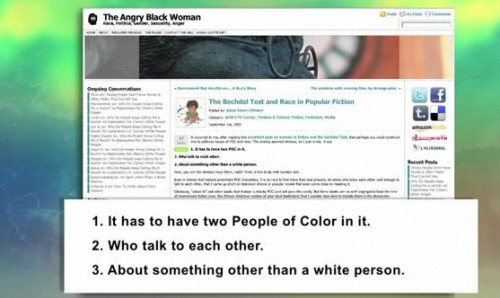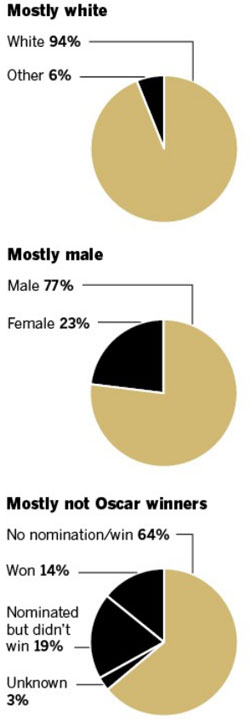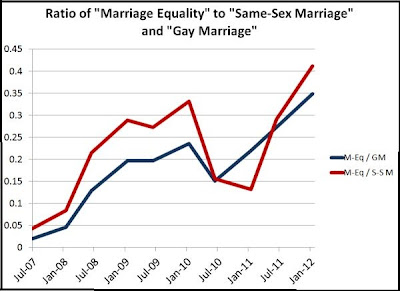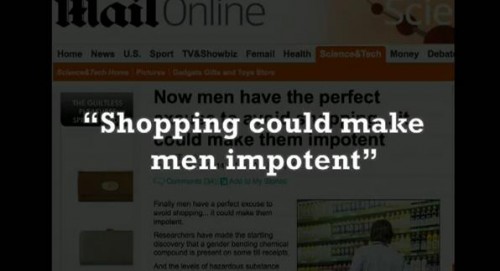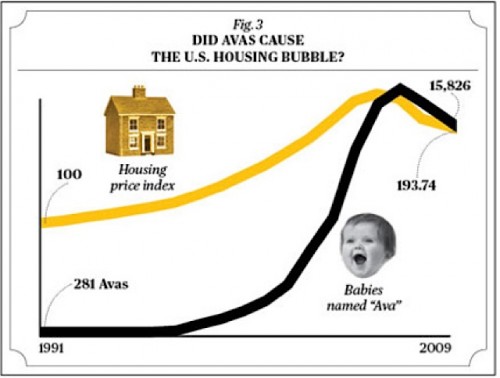Yesterday I posted the results of an L.A. Times study on the demographics of the Academy voters who decide who receives Oscars. What about the movies they’ll be voting on this year? The always-awesome Anita Sarkeesian, of Feminist Frequency, produced a short video applying the Bechdel test — the simple measure of even minimal representation of women in film — to the 2012 Oscar nominees, as well as a racial version of the Bechdel test that looks at how non-Whites are included. The results are not encouraging:
media
This Sunday is the 2012 Oscars ceremony. The Oscars are awarded based on the votes of nearly 6,000 members of the Academy of Motion Picture Arts and Sciences; however, the Academy keeps the identities of the voting members secret, so there’s little knowledge of who, exactly, determines the recipients of Oscars, prestigious awards within the industry that can increase interest in a film, increase job opportunities, and generally raise the profile of winners.
Sangyoub Park sent in a link to an article at the L.A. Times story about Academy voters. Times reporters were able to verify the identity of 89% of current voters, and the paper provided this breakdown of their demographics; as it turns out, those deciding who wins an Oscar are overwhelmingly White non-Hispanic and male:
Within some categories of voting members, Whites are even more dominant; they make up 98% of writers and executives. Voters are also disproportionately older; the median age is 62, and the Times reports that only 14% were under age 50.
As the Times story illustrates, many inside and outside of the film industry believe the make-up of Oscar voters influences which movies, actors, and directors have a serious chance of winning, with those that appeal to middle-aged White men inherently advantaged because of the lack of diversity among voters.
This photograph is of the Love Canal neighborhood in Niagara Falls, New York, where Hooker Chemical (now Occidental Petroleum Corporation) buried 21,000 tons of toxic, chemical waste:
 In 1953, Hooker Chemical sold the land that they had been using for toxic waste disposal to the Niagara Falls School Board for $1. The sale deed contained warnings about the chemical waste and a disclaimer of liability. However, planners hastily built schools and homes on the contaminated land to accommodate the city’s growing postwar population. By the late 1970s, residents were reporting a litany of illnesses and birth defects. Scientists discovered high levels of carcinogens in the soil, groundwater, and air. The community mobilized to bring attention to the situation, and President Carter declared a federal health emergency in the area.
In 1953, Hooker Chemical sold the land that they had been using for toxic waste disposal to the Niagara Falls School Board for $1. The sale deed contained warnings about the chemical waste and a disclaimer of liability. However, planners hastily built schools and homes on the contaminated land to accommodate the city’s growing postwar population. By the late 1970s, residents were reporting a litany of illnesses and birth defects. Scientists discovered high levels of carcinogens in the soil, groundwater, and air. The community mobilized to bring attention to the situation, and President Carter declared a federal health emergency in the area.
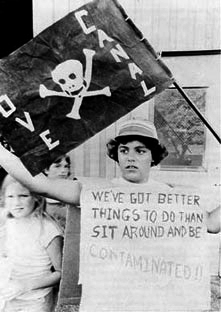 Elizabeth Blum, a professor of history at Troy University, has written about the environmental activism of Love Canal residents. Such activism, called “popular epidemiology,” attempts to link spikes in localized health issues to their origins. Despite such grassroots movements, though, the media tends to show little interest in the causes of cancer and greater interest in finding the cure.
Elizabeth Blum, a professor of history at Troy University, has written about the environmental activism of Love Canal residents. Such activism, called “popular epidemiology,” attempts to link spikes in localized health issues to their origins. Despite such grassroots movements, though, the media tends to show little interest in the causes of cancer and greater interest in finding the cure.
The many “Stand Up to Cancer” ads, for example, urge people to donate money (or just use their credit card for purchases) to help fund the development of cancer treatments:
When media attention is focused on the causes of cancer, it usually takes an individualistic tone. Risk factors (smoking, poor diet, etc.) are blamed for various forms of cancer.
The thing is: there’s no money in prevention.
Mainstream media outlets have a vested interest in not exposing the causes of cancer. The companies that pay to advertise on their channels, and often their parent companies or subsidiaries, often traffic in known carcinogens. Pharmaceutical companies, likewise, have a perverse incentive. Healthy people make them no money, neither do dead people; sick people though, they’re a goldmine. Many organizations, including the multi-million dollar Susan G. Komen Foundation, are in the business of raising money “for the cure,” more so than prevention.
The politics of cancer, then suffer from the individualism characteristic of modern American and capitalist imperatives, leaving the causes of the cancer epidemic invisible and, accordingly, the unethical and illegal behavior of companies like Hooker Chemical.
Dan Rose is an assistant professor of sociology at Chattanooga State Community College in Tennessee. His research focuses on medical sociology and health inequalities in minority neighborhoods.
Lisa Wade, PhD is an Associate Professor at Tulane University. She is the author of American Hookup, a book about college sexual culture; a textbook about gender; and a forthcoming introductory text: Terrible Magnificent Sociology. You can follow her on Twitter and Instagram.
In 1964, in Jacobellis v. Ohio, a case regarding an allegedly obscene film, Supreme Court Justice Stewart Potter Stewart famously wrote in his opinion,
I shall not today attempt further to define the kinds of material I understand to be embraced within that shorthand description [of hard-core pornography]…But I know it when I see it…
Of course, the problem is that not everyone has the same reaction to what they see. While the 1964 case specifically dealt with a film, and a judgment on whether it crossed the line from pornographic (legal) to obscene (not), similar arguments are common regarding what is appropriate on TV. The Federal Communications Commission may impose penalties, including large fines or revoking a broadcaster’s license, on networks that air “indecent or profane programming during certain hours.” Last month the Supreme Court agreed to hear a case regarding the FCC’s regulations and whether they violate free speech guarantees.
Dmitriy T.M. sent in a segment from The Daily Show that highlights some of the inconsistencies and contradictions in the FCC’s standards for prime time, and the seeming arbitrariness of decisions about what is “indecent”:
Cross-posted at Montclair SocioBlog.
It can take a while to find the right word. But a mot juste may be crucial for framing a political issue. If you like the idea of men being able to marry men, and women women, what should you call the new laws that would allow that?
The trouble with “gay marriage” and even “same-sex marriage” is that these terms suggest – especially to conservatives – some kind of special treatment for the minority. It’s as though gays are getting a marriage law just for them.
At last, the gay marriage forces seem to have come up with a term that invokes not special treatment but a widely-held American value that’s for everyone – equality. A bill in New Jersey has been in the news this week, mostly because Gov. Christie says he will veto it. The bill is a “marriage equality” law.
The governor is in a bit of a squeeze. As a Republican with ambitions beyond New Jersey’s borders, he can’t very well be for gay marriage. But if his opponents can frame the matter their way, he now has to come out against equality. Which is why the governor continues to refer to the issue as “same-sex marriage.”*
It’s like “abortion rights” or even “women’s rights.” A phrase like that might rally women to your cause, but if you want broader support, you need a flag that every American can salute. I’m not familiar with the history of abortion rights so I don’t know how it happened, but those who want to keep abortion legal have managed to frame the issue as one of freedom to choose. They have been so successful that the media routinely refer to their side as “pro-choice.” To oppose them is to oppose both freedom and individual choice, principles which occupy a high place in the pantheon of American values.
It’s not clear that the “marriage equality” movement has been similarly successful, at least not yet. I did a quick Lexis-Nexis search sampling the last week of the months January and July going back to 2007. I looked for three terms: “same-sex marriage,” “gay marriage,” and “marriage equality.”
The general trend for all three is upwards as more legislatures consider bills, with big jumps when a vote becomes big news – that blip in July 2011 is the New York State vote. But the graph can’t quite show how “marriage equality” has risen from obscurity. That first data point, July 2007, is a 4. Four mentions of “marriage equality” while the other terms had 25 and 50 times that many. As of last week, “gay” and “same sex” still outnumber “equality,” but the score is not nearly so lopsided.
Here is a graph of the ratio of “equality” to each of the other two terms. From nearly 1 : 20 (one “marriage equality” for every 20 “gay marriages”) the ratio has increased to 1 : 3 and even higher when the discussion gets active.
If the movement is successful, that upward trend should continue. When you hear Fox News referring to “marriage equality laws,” you’ll know it’s game over.
———————————
* Christie is usually politically adept, but he’s stumbling on this one. He referred to a gay legislator as “numb nuts” (literally, that might not necessarily be a liability for a politician caught in a squeeze). Christie also said that he’s vetoing the bill so that the matter can be put on the ballot as a referendum – you know, like what should have happened with civil rights in the South.
I think people would have been happy to have a referendum on civil rights rather than fighting and dying in the streets in the South.
Several critics, including Numb Nuts, responded that, yes, Southern whites would have been happy to have civil rights left up to the majority. African Americans not so much. (If you’re looking for an illustration of Tocqueville’s “tyranny of the majority,” the post-Reconstruction South might be a good place to start.) The analogy is obvious – race : 1962 :: sexual orientation : 2012 – even if it was not the message the governor intended.
 The phrase “Magical Negro” refers to the phenomenon in which a white character in a tv show or movie finds enlightenment through the wisdom of a Black character. It is widely considered an offensive trope in which Black people — imbued with special spiritual, religious, or primitive powers of insight, often ostensibly due to some disadvantage like poverty — serve only to support a white person’s transformation. The white person, and their ultimate redemption, remains the central story.
The phrase “Magical Negro” refers to the phenomenon in which a white character in a tv show or movie finds enlightenment through the wisdom of a Black character. It is widely considered an offensive trope in which Black people — imbued with special spiritual, religious, or primitive powers of insight, often ostensibly due to some disadvantage like poverty — serve only to support a white person’s transformation. The white person, and their ultimate redemption, remains the central story.
I couldn’t help but think of this when I watched the trailer for The Best Exotic Marigold Hotel, sent in by Katrin. In this trailer, the Magical Negro isn’t a Black person; it’s not even a person. It’s the entire country of India.
See if you see what I saw:
For examples of the Magical Negro, see our post on The Secret Life of Bees, the Magical Negro at Ikea, and the Magical Aboriginal Child in an Australian tourism ad.
Lisa Wade, PhD is an Associate Professor at Tulane University. She is the author of American Hookup, a book about college sexual culture; a textbook about gender; and a forthcoming introductory text: Terrible Magnificent Sociology. You can follow her on Twitter and Instagram.
Dmitriy T.M. sent in a TED talk in which Ben Goldacre discusses the problems with many of the scientific findings we hear about in the media, highlighting the importance of scientific literacy and critical consumption of science reporting:
And while we’re on the topic of potentially misleading statistics, Dolores R. and Sarah E. sent in an image posted at boing boing as one of “the best set of infographics ever,” helpfully illustrating the difference between correlation and causation:
 In “Portraying Tiger Woods: Characterizations of a ‘Black’ Athlete in a ‘White’ Sport,” Andrew Billings discusses how race plays a role in sports commentators’ evaluations of golfers, and particularly in how they describe and comment upon Tiger Woods. A content analysis of 37.5 hours of coverage of golf tournaments between April and August of 2001 by CBS, NBC, and ABC, during which 2,989 evaluative comments occurred, revealed patterns in how sportscasters described Tiger Woods compared to other golfers. When he was losing, Woods was more likely than other golfers in the same position to be described as lacking composure or concentration, of “self-destructing,” and of lacking control over his emotions. Overall, Billings found that the types of language other students have found to be applied to Black athletes were applied to Woods only when he was losing. When he was doing well, commentators did not significantly stereotype Woods.
In “Portraying Tiger Woods: Characterizations of a ‘Black’ Athlete in a ‘White’ Sport,” Andrew Billings discusses how race plays a role in sports commentators’ evaluations of golfers, and particularly in how they describe and comment upon Tiger Woods. A content analysis of 37.5 hours of coverage of golf tournaments between April and August of 2001 by CBS, NBC, and ABC, during which 2,989 evaluative comments occurred, revealed patterns in how sportscasters described Tiger Woods compared to other golfers. When he was losing, Woods was more likely than other golfers in the same position to be described as lacking composure or concentration, of “self-destructing,” and of lacking control over his emotions. Overall, Billings found that the types of language other students have found to be applied to Black athletes were applied to Woods only when he was losing. When he was doing well, commentators did not significantly stereotype Woods.
The study is interesting in light of a video sent in by Jason Eastman. This Wall Street Journal segment discusses the results of a study that investigated how media depictions of college quarterbacks’ performances. A recent study published in the Academic of Management Journal found that media coverage rarely gave African American quarterbacks credit for leadership. When their teams do well, it is because of their natural athletic talent; when they do poorly, it is lack of leadership — blame not equally placed on White quarterbacks when their teams do poorly. So Blacks are blamed more for losses but get less credit for successes — an outcome of stereotyping that has disturbing implications for hiring and promotion in the workplace (sorry for the ad):
Full cites:
Andrew Billings. 2003. “Portraying Tiger Woods: Characterizations of a ‘Black’ Athlete in a ‘White’ Sport.” The Howard Journal of Communications 14: 29-37.
Andrew Carton and Ashleigh Shelby Rosette. 2011. “Explaining Bias against Black Leaders: Integrating Theory on Information Processing and Goal-Based Stereotyping.” Academy of Management Journal 54: 1141-1158.
This Sunday is the 2012 Oscars ceremony. The Oscars are awarded based on the votes of nearly 6,000 members of the Academy of Motion Picture Arts and Sciences; however, the Academy keeps the identities of the voting members secret, so there’s little knowledge of who, exactly, determines the recipients of Oscars, prestigious awards within the industry that can increase interest in a film, increase job opportunities, and generally raise the profile of winners.
Sangyoub Park sent in a link to an article at the L.A. Times story about Academy voters. Times reporters were able to verify the identity of 89% of current voters, and the paper provided this breakdown of their demographics; as it turns out, those deciding who wins an Oscar are overwhelmingly White non-Hispanic and male:
Within some categories of voting members, Whites are even more dominant; they make up 98% of writers and executives. Voters are also disproportionately older; the median age is 62, and the Times reports that only 14% were under age 50.
As the Times story illustrates, many inside and outside of the film industry believe the make-up of Oscar voters influences which movies, actors, and directors have a serious chance of winning, with those that appeal to middle-aged White men inherently advantaged because of the lack of diversity among voters.
This photograph is of the Love Canal neighborhood in Niagara Falls, New York, where Hooker Chemical (now Occidental Petroleum Corporation) buried 21,000 tons of toxic, chemical waste:
 In 1953, Hooker Chemical sold the land that they had been using for toxic waste disposal to the Niagara Falls School Board for $1. The sale deed contained warnings about the chemical waste and a disclaimer of liability. However, planners hastily built schools and homes on the contaminated land to accommodate the city’s growing postwar population. By the late 1970s, residents were reporting a litany of illnesses and birth defects. Scientists discovered high levels of carcinogens in the soil, groundwater, and air. The community mobilized to bring attention to the situation, and President Carter declared a federal health emergency in the area.
In 1953, Hooker Chemical sold the land that they had been using for toxic waste disposal to the Niagara Falls School Board for $1. The sale deed contained warnings about the chemical waste and a disclaimer of liability. However, planners hastily built schools and homes on the contaminated land to accommodate the city’s growing postwar population. By the late 1970s, residents were reporting a litany of illnesses and birth defects. Scientists discovered high levels of carcinogens in the soil, groundwater, and air. The community mobilized to bring attention to the situation, and President Carter declared a federal health emergency in the area.
 Elizabeth Blum, a professor of history at Troy University, has written about the environmental activism of Love Canal residents. Such activism, called “popular epidemiology,” attempts to link spikes in localized health issues to their origins. Despite such grassroots movements, though, the media tends to show little interest in the causes of cancer and greater interest in finding the cure.
Elizabeth Blum, a professor of history at Troy University, has written about the environmental activism of Love Canal residents. Such activism, called “popular epidemiology,” attempts to link spikes in localized health issues to their origins. Despite such grassroots movements, though, the media tends to show little interest in the causes of cancer and greater interest in finding the cure.
The many “Stand Up to Cancer” ads, for example, urge people to donate money (or just use their credit card for purchases) to help fund the development of cancer treatments:
When media attention is focused on the causes of cancer, it usually takes an individualistic tone. Risk factors (smoking, poor diet, etc.) are blamed for various forms of cancer.
The thing is: there’s no money in prevention.
Mainstream media outlets have a vested interest in not exposing the causes of cancer. The companies that pay to advertise on their channels, and often their parent companies or subsidiaries, often traffic in known carcinogens. Pharmaceutical companies, likewise, have a perverse incentive. Healthy people make them no money, neither do dead people; sick people though, they’re a goldmine. Many organizations, including the multi-million dollar Susan G. Komen Foundation, are in the business of raising money “for the cure,” more so than prevention.
The politics of cancer, then suffer from the individualism characteristic of modern American and capitalist imperatives, leaving the causes of the cancer epidemic invisible and, accordingly, the unethical and illegal behavior of companies like Hooker Chemical.
Dan Rose is an assistant professor of sociology at Chattanooga State Community College in Tennessee. His research focuses on medical sociology and health inequalities in minority neighborhoods.
Lisa Wade, PhD is an Associate Professor at Tulane University. She is the author of American Hookup, a book about college sexual culture; a textbook about gender; and a forthcoming introductory text: Terrible Magnificent Sociology. You can follow her on Twitter and Instagram.
In 1964, in Jacobellis v. Ohio, a case regarding an allegedly obscene film, Supreme Court Justice Stewart Potter Stewart famously wrote in his opinion,
I shall not today attempt further to define the kinds of material I understand to be embraced within that shorthand description [of hard-core pornography]…But I know it when I see it…
Of course, the problem is that not everyone has the same reaction to what they see. While the 1964 case specifically dealt with a film, and a judgment on whether it crossed the line from pornographic (legal) to obscene (not), similar arguments are common regarding what is appropriate on TV. The Federal Communications Commission may impose penalties, including large fines or revoking a broadcaster’s license, on networks that air “indecent or profane programming during certain hours.” Last month the Supreme Court agreed to hear a case regarding the FCC’s regulations and whether they violate free speech guarantees.
Dmitriy T.M. sent in a segment from The Daily Show that highlights some of the inconsistencies and contradictions in the FCC’s standards for prime time, and the seeming arbitrariness of decisions about what is “indecent”:
Cross-posted at Montclair SocioBlog.
It can take a while to find the right word. But a mot juste may be crucial for framing a political issue. If you like the idea of men being able to marry men, and women women, what should you call the new laws that would allow that?
The trouble with “gay marriage” and even “same-sex marriage” is that these terms suggest – especially to conservatives – some kind of special treatment for the minority. It’s as though gays are getting a marriage law just for them.
At last, the gay marriage forces seem to have come up with a term that invokes not special treatment but a widely-held American value that’s for everyone – equality. A bill in New Jersey has been in the news this week, mostly because Gov. Christie says he will veto it. The bill is a “marriage equality” law.
The governor is in a bit of a squeeze. As a Republican with ambitions beyond New Jersey’s borders, he can’t very well be for gay marriage. But if his opponents can frame the matter their way, he now has to come out against equality. Which is why the governor continues to refer to the issue as “same-sex marriage.”*
It’s like “abortion rights” or even “women’s rights.” A phrase like that might rally women to your cause, but if you want broader support, you need a flag that every American can salute. I’m not familiar with the history of abortion rights so I don’t know how it happened, but those who want to keep abortion legal have managed to frame the issue as one of freedom to choose. They have been so successful that the media routinely refer to their side as “pro-choice.” To oppose them is to oppose both freedom and individual choice, principles which occupy a high place in the pantheon of American values.
It’s not clear that the “marriage equality” movement has been similarly successful, at least not yet. I did a quick Lexis-Nexis search sampling the last week of the months January and July going back to 2007. I looked for three terms: “same-sex marriage,” “gay marriage,” and “marriage equality.”
The general trend for all three is upwards as more legislatures consider bills, with big jumps when a vote becomes big news – that blip in July 2011 is the New York State vote. But the graph can’t quite show how “marriage equality” has risen from obscurity. That first data point, July 2007, is a 4. Four mentions of “marriage equality” while the other terms had 25 and 50 times that many. As of last week, “gay” and “same sex” still outnumber “equality,” but the score is not nearly so lopsided.
Here is a graph of the ratio of “equality” to each of the other two terms. From nearly 1 : 20 (one “marriage equality” for every 20 “gay marriages”) the ratio has increased to 1 : 3 and even higher when the discussion gets active.
If the movement is successful, that upward trend should continue. When you hear Fox News referring to “marriage equality laws,” you’ll know it’s game over.
———————————
* Christie is usually politically adept, but he’s stumbling on this one. He referred to a gay legislator as “numb nuts” (literally, that might not necessarily be a liability for a politician caught in a squeeze). Christie also said that he’s vetoing the bill so that the matter can be put on the ballot as a referendum – you know, like what should have happened with civil rights in the South.
I think people would have been happy to have a referendum on civil rights rather than fighting and dying in the streets in the South.
Several critics, including Numb Nuts, responded that, yes, Southern whites would have been happy to have civil rights left up to the majority. African Americans not so much. (If you’re looking for an illustration of Tocqueville’s “tyranny of the majority,” the post-Reconstruction South might be a good place to start.) The analogy is obvious – race : 1962 :: sexual orientation : 2012 – even if it was not the message the governor intended.
 The phrase “Magical Negro” refers to the phenomenon in which a white character in a tv show or movie finds enlightenment through the wisdom of a Black character. It is widely considered an offensive trope in which Black people — imbued with special spiritual, religious, or primitive powers of insight, often ostensibly due to some disadvantage like poverty — serve only to support a white person’s transformation. The white person, and their ultimate redemption, remains the central story.
The phrase “Magical Negro” refers to the phenomenon in which a white character in a tv show or movie finds enlightenment through the wisdom of a Black character. It is widely considered an offensive trope in which Black people — imbued with special spiritual, religious, or primitive powers of insight, often ostensibly due to some disadvantage like poverty — serve only to support a white person’s transformation. The white person, and their ultimate redemption, remains the central story.
I couldn’t help but think of this when I watched the trailer for The Best Exotic Marigold Hotel, sent in by Katrin. In this trailer, the Magical Negro isn’t a Black person; it’s not even a person. It’s the entire country of India.
See if you see what I saw:
For examples of the Magical Negro, see our post on The Secret Life of Bees, the Magical Negro at Ikea, and the Magical Aboriginal Child in an Australian tourism ad.
Lisa Wade, PhD is an Associate Professor at Tulane University. She is the author of American Hookup, a book about college sexual culture; a textbook about gender; and a forthcoming introductory text: Terrible Magnificent Sociology. You can follow her on Twitter and Instagram.
Dmitriy T.M. sent in a TED talk in which Ben Goldacre discusses the problems with many of the scientific findings we hear about in the media, highlighting the importance of scientific literacy and critical consumption of science reporting:
And while we’re on the topic of potentially misleading statistics, Dolores R. and Sarah E. sent in an image posted at boing boing as one of “the best set of infographics ever,” helpfully illustrating the difference between correlation and causation:
 In “Portraying Tiger Woods: Characterizations of a ‘Black’ Athlete in a ‘White’ Sport,” Andrew Billings discusses how race plays a role in sports commentators’ evaluations of golfers, and particularly in how they describe and comment upon Tiger Woods. A content analysis of 37.5 hours of coverage of golf tournaments between April and August of 2001 by CBS, NBC, and ABC, during which 2,989 evaluative comments occurred, revealed patterns in how sportscasters described Tiger Woods compared to other golfers. When he was losing, Woods was more likely than other golfers in the same position to be described as lacking composure or concentration, of “self-destructing,” and of lacking control over his emotions. Overall, Billings found that the types of language other students have found to be applied to Black athletes were applied to Woods only when he was losing. When he was doing well, commentators did not significantly stereotype Woods.
In “Portraying Tiger Woods: Characterizations of a ‘Black’ Athlete in a ‘White’ Sport,” Andrew Billings discusses how race plays a role in sports commentators’ evaluations of golfers, and particularly in how they describe and comment upon Tiger Woods. A content analysis of 37.5 hours of coverage of golf tournaments between April and August of 2001 by CBS, NBC, and ABC, during which 2,989 evaluative comments occurred, revealed patterns in how sportscasters described Tiger Woods compared to other golfers. When he was losing, Woods was more likely than other golfers in the same position to be described as lacking composure or concentration, of “self-destructing,” and of lacking control over his emotions. Overall, Billings found that the types of language other students have found to be applied to Black athletes were applied to Woods only when he was losing. When he was doing well, commentators did not significantly stereotype Woods.
The study is interesting in light of a video sent in by Jason Eastman. This Wall Street Journal segment discusses the results of a study that investigated how media depictions of college quarterbacks’ performances. A recent study published in the Academic of Management Journal found that media coverage rarely gave African American quarterbacks credit for leadership. When their teams do well, it is because of their natural athletic talent; when they do poorly, it is lack of leadership — blame not equally placed on White quarterbacks when their teams do poorly. So Blacks are blamed more for losses but get less credit for successes — an outcome of stereotyping that has disturbing implications for hiring and promotion in the workplace (sorry for the ad):
Full cites:
Andrew Billings. 2003. “Portraying Tiger Woods: Characterizations of a ‘Black’ Athlete in a ‘White’ Sport.” The Howard Journal of Communications 14: 29-37.
Andrew Carton and Ashleigh Shelby Rosette. 2011. “Explaining Bias against Black Leaders: Integrating Theory on Information Processing and Goal-Based Stereotyping.” Academy of Management Journal 54: 1141-1158.

